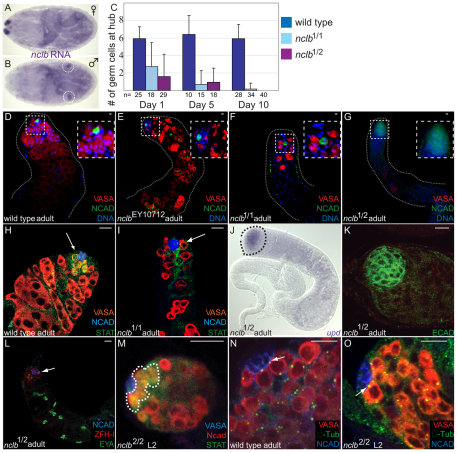Fig. 1.
nclb is required for male GSC maintenance. (A,B) In situ hybridization in stage 17 embryos reveals that nclb is expressed in male gonads and not female gonads. Staining in A is paternal X marker. Gonads are circled in B. (C) nclb mutants exhibit a reduced number of germline cells proximal to the hub compared with wild type (all wild type in this figure are a precise excision allele of EY10712). (D-G) Five-day-old adult testes immunostained for germ cells (VASA, red), hub cells (NCAD, green) and DNA (DAPI, blue). Note that nclb mutant testes exhibit germline loss relative to wild type that is more severe in stronger loss-of-function nclb mutants (e.g. G). (H,I) Newly eclosed adult testes immunostained for germ cells (VASA, red), hub cells (NCAD, blue) and STAT92E (anti-STAT92E, green). Germ cells adjacent to the hub (arrows) in nclb mutant testes do not exhibit anti-STAT 92E immunoreactivity. (J) Adult nclb mutant testis labeled by in situ hybridization for upd. Outline indicates apical end of testis. (K) nclb mutant adult testis immunostained for DE-cadherin (green). Note that the hub is also enlarged in nclb mutants. (L) nclb mutant adult testis immunolabeled for cyst stem cells (anti-ZFH-1, red, arrow), late somatic cyst cells (anti-EYA, green) and the hub (anti-NCAD, blue). Arrow indicates cyst stem cell. (M) Immunostaining of STAT92E (outline) is restricted to GSC in larval nclb mutant testis. (N,O) Centrosomes visualized with γ-tubulin antibody (green, arrows) are properly oriented in nclb mutant L2 larval testis (O), similar to wild-type adult (N) and larvae (not shown). Scale bars: 10 μm.

